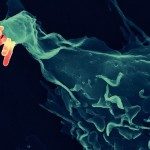Lien vers Pubmed [PMID] – 20070313
Cell. Microbiol. 2010 Apr;12(4):545-56
Escape into the host cell cytosol following invasion of mammalian cells is a common strategy used by invasive pathogens. This requires membrane rupture of the vesicular or vacuolar compartment formed around the bacteria after uptake into the host cell. The mechanism of pathogen-induced disassembly of the vacuolar membrane is poorly understood. We established a novel, robust and sensitive fluorescence microscopy method that tracks the precise time point of vacuole rupture upon uptake of Gram-negative bacteria. This revealed that the enteroinvasive pathogen Shigella flexneri escapes rapidly, in less than 10 min, from the vacuole. Our method demonstrated the recruitment of host factors, such as RhoA, to the bacterial entry site and their continued presence at the point of vacuole rupture. We found a novel host marker for ruptured vacuoles, galectin-3, which appears instantly in the proximity of bacteria after escape into the cytosol. Furthermore, we show that the Salmonella effector proteins, SifA and PipB2, stabilize the vacuole membrane inhibiting bacterial escape from the vacuole. Our novel approach to track vacuole rupture is ideally suited for high-content and high-throughput approaches to identify the molecular and cellular mechanisms of membrane rupture during invasion by pathogens such as viruses, bacteria and parasites.


